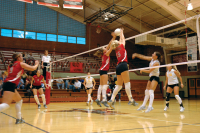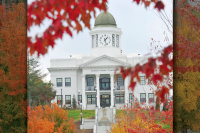The price of being certifiably ‘green’
Go into any store and you run into the term “green.” Bags of chips, detergents, new cars and fluorescent-light bulbs — all are bedizened in alleged greenness.
But what, exactly, does green mean? And who should get to declare themselves green? Should low-flow toilets get the same credit as solar panels?
In the building industry, the question isn’t academic — it’s critical to the bottom line. Green buildings and homes command a higher price tag. But the cost of true, environmentally friendly building is also steep. So how green is green?
That’s where LEED comes in. LEED, which stands for Leadership in Energy and Environmental Design, is a third-party green-building rating system that certifies buildings based on their merits as environmentally sustainable structures.
There are various incarnations of LEED — LEED for homes, for existing buildings, for retail, for health care, for commercial interiors — and different levels within each: certified (basic level), silver, gold and platinum, and the ranks are handed out based on points in five categories.
LEED is fairly customizable from building to building; which is a plus, given that what might be a massive, energy-saving measure in one structure would create trivial benefits to another. Builders can pick which categories they want more points in, and then which measures and materials they want to use to get them.
Paying a green price
But it’s costly. The price of LEED-style building over traditional methods is about 2 percent, said Scott Donald of Padgett and Freeman Architects in Asheville. About a quarter of Donald’s business is in LEED projects.
Fees vary, depending on size and which LEED program is giving the award, but for a large commercial building, a construction and design review can run as high as $27,000. And when it comes down to the bottom line, sometimes the merits of being certified don’t outweigh the costs — especially when all the environmental elements can be built in without certification. So property owners who might have come in liking the ranking may opt to sidestep it, building a LEED building without the LEED name.
“It actually occurs a lot,” said Donald, “because they don’t want to pay for the actual certification and the energy models, and the design is pretty much the same.”
That fee? It pays for extensive documentation. And in return, LEED provides an outsider arbiter, making sure everything is done properly.
“That’s where you lose by not doing LEED is during the construction process,” said Donald. “The end product is very similar, but the process is not at all. That’s part of what LEED does.”
But the real treasure that LEED has to offer is its name — a recognized brand of environmental friendliness.
“The value of a certification comes in when you’re trying to sell a building. That’s where that brand comes in,” said Maggie Leslie, the program director for the Western North Carolina Green Building Council, which helps builders navigate the LEED process.
“For someone who’s trying to sell a home or a building, instead of trying to explain all the terms, it’s a marketing program. It’s to help people communicate the value of these things.”
A trend that keeps on growing
George Ford, an assistant professor at Western Carolina University, teaches construction management. Recently, he’s been teaching a lot more about LEED. From the contractor’s perspective, the view is the same as from the owner’s; knowing green-building practices isn’t the same as knowing LEED building practices.
“A lot of times, that could be the difference between them getting the job and not getting the job,” said Ford.
Because of that, the professor has seen an increase in LEED certifications over the last several years.
In a tough construction industry, any edge is a good edge, especially if it offers true legitimacy in a quagmire of faux green.
And, for a quick bit of history, that’s why it was created.
“LEED has been around for 10 years, and it was created out of a response and a cry from the building community saying, ‘We want to stand out. There is no standard, and how do we separate ourselves from anyone else who says that they’re green?’” said Emily Scofield. She’s the executive director for the Charlotte region chapter of the U.S. Green Building Council, the third party in third-party ratings system. They’re the ones that give out LEED badges.
Scofield views LEED as less a selling point and more as a mark of quality. She said the benefits of adhering to the system’s high standards are self-evident and good for health, the earth and the bottom line.
A 2010 McGraw Hill study found that, for new buildings built to LEED standards, operating costs dropped by just over 13 percent — eight for existing buildings that were retrofitted — while the value of new LEED buildings rose nearly 11 percent, compared to what it would’ve brought traditionally.
That’s part of why Donald is so successful in convincing his clients to go for sustainably designed buildings, whether they get the LEED stamp or not.
“If you meet the goals that LEED establishes, you’re going to save a lot of money,” said Donald, pointing to one of his recent projects, the new Cherokee Central Schools complex, as an example.
“Right now, they’re probably saving over a quarter of a million dollars a year,” said Donald, and he projected that the tribe would save $10 million over the life of the buildings.
And that, of course, is the basic premise of good branding. LEED isn’t just a name. It’s a symbol of quality and a promise that green really does mean green. People know and trust it, and that’s got a good deal of intrinsic value.
But they’re not the only player in the game. There are more green ratings systems out there. Some, like Energy Star, work in concert with LEED; some are in competition with it.
Different programs have their own merits, including, for many, lower fees. But in this relatively young market, LEED is still the front-runner, the internationally recognized standard that serves as the benchmark.
“I think that competition is good, and ultimately we’re all trying to achieve the same goal,” said Scofield. “If their intent is true, we don’t mind the competition.”
And really, LEED will have to keep evolving, not only to stay ahead of the competition, but to stay in business altogether. The general consensus among architects and builders alike is that the standards that are LEED today will simply be the building code tomorrow, rendering LEED and its ilk obsolete, at least in their current forms.
Today, new technologies like solar power and geothermal wells are becoming the next wave of green trends, but in five years time, the leading edge of the green movement will be somewhere else entirely, which will always leave LEED, and the professionals who follow it, somewhere greener to grow.
Many buildings certifiably green; others just follow the LEED
What do Harrill Residence Hall at Western Carolina University, the Cherokee Central School System, the new Oconaluftee Visitor Center in the Smokies and the firehouse in Sylva have in common?
Each of these projects help make a whole: they are part of a burgeoning green-building trend in Western North Carolina that, in recent years, has seen sustainable commercial construction become less of a niche and more of the norm.
“It is definitely becoming mainstream,” said Lauren Bishop, campus energy manager for WCU, where a green retrofitting of Harrill dorm is under way and the earth friendly Health and Human Sciences Building was recently completed.
These green buildings use less power and water, are often built in a pre-existing footprint, produce less waste and use recycled materials. Most incorporate more natural light and fresh air than standard commercial buildings.
Some are certified sustainable, others are not: LEED (Leadership in Energy and Environmental Design) certification is the recognized standard (see sidebar on LEED certification). But that stamp of approval comes at a recurring annual cost and a whole lot of paperwork.
SEE ALSO: The price of being certifiably ‘green’
As George Stanley, projects manager for Southwestern Community College, put it when describing the non-certified but sustainable Conrad G. Burrell administration/bookstore building under way there, one can have a perfectly fantastic pedigree dog without having in hand the actual pedigree papers.
With or without the certification, WNC architects and local governments are paying increasing attention to sustainable building practices.
Not just green: healthy
Scott Donald is a principal architect with Padgett and Freeman Architects. The Asheville company drafted the plans for the massive new campus that’s home to Cherokee Central Schools, as well as the tribal emergency operations center. Both are LEED certified, but Donald said that he would try to bring environmental sustainability to the projects even without the certification, just because it’s his professional habit.
“This office has been doing that since the early 70s,” Donald said. “It’s really just environmentally conscious architecture.”
The schools in particular are chockablock with sustainable measures. It’s a sprawling, 473,000-square-foot campus that houses kindergarten through high school and incorporates green technology at every turn. There are waterless urinals, daylight sensors in every room to maximize natural light and minimize the artificial light used, underground cisterns stowed beneath the schools’ courtyards that can hold 60,000 gallons of rainwater for irrigation and toilet flushing. And, the school is heated by 450-foot geothermal wells that were drilled beneath the school to make use of the earth’s warmth.
The project cost $140 million, but Yona Wade, director of the school’s cultural arts center, said the benefits are worth the extra money spent to LEED certify the buildings. The measures will save the school system money in the long term — $10 million over 40 years, according to Donald.
In Cherokee, the impetus for green building is largely rooted in a 2009 environmental proclamation made by Principal Chief Michell Hicks. He directed the tribe toward greater care for the environment in its policies.
“It comes from wanting to be good stewards of what we have,” Wade said. “This has got to be the building that will last us. We’ll probably never do this again.”
The sun and the wind are free
O’Dell Thompson, a Sylva architect, has chosen not to take the classes and pay the fees necessary to get LEED certified. But he designs in an environmentally friendly manner “because that’s the right thing to do.”
“I do a lot of houses, churches and stuff,” Thompson said. “With all of my clients, I encourage them to take advantage of the things that are free — the sun and the wind.”
Thompson was the architect on Sylva’s new firehouse.
He remembers that when Sylva leaders were developing the concept for the new firehouse, then Mayor Brenda Oliver emphasized, “no matter what, it should be as environmentally sensitive as possible,” Thompson said. “So that was one of our goals from the outset.”
Last fall, the firehouse was completed. Not too many years ago the obviously sustainable building might have seemed incongruous in this mountain town of just 2,500, with its large solar panels displayed prominently on the roof. But these days? It really hasn’t occasioned much comment.
There is a solar pre-heating hot water system that heats water to circulate under the slabs where the fire trucks rest when not in use. This saves propane costs — you can’t let a fire truck, full of potentially lifesaving water, freeze during the winter. The slab retains heat because it has thermal mass, which helps keep temperatures warmer.
Up to eight solar tubes help with lighting the firehouse. So much so, Thompson said a butterfly baffle had to be installed near the television so that the firemen could see the screen. The building is south facing, and there’s an overhang to prevent heat buildup in summer and accept heat during the winter.
There are photovoltaics, which is a method of generating power by converting solar radiation into direct current electricity. There are no batteries being charged, the electricity generated simply offsets any electric costs.
The firehouse is metal, meaning parts of it were probably recycled; the men’s room has a waterless urinal to save on water use.
The building avoids the use of volatile organic compounds in the paints or carpet.
“It’s not just green,” Thompson said. “It’s an environmentally healthy structure.”
Green building helps bottom line
Tim Chapman is the associate director for facilities in the office of residential living at WCU. He’s a practical kind of fellow, one who clearly understands and appreciates the virtue and necessity of the bottom line.
“We’re a business,” Chapman said. “Everything we do must be done in sound business terms.”
Each of the 13 buildings he helps oversee is an individual “cost center,” meaning they have to cost out each year, bringing in enough money to offset expenses. But these days, that doesn’t exclude incorporating green practices — in fact, sustainable building techniques can save you money, Chapman said.
“The desire has been there for years, but the manufacturing process and science (of green building) is catching up,” he said.
WCU has reused sites instead of eating up more green space as it has entered a new building phase in recent years. More green space, in fact, has been added on campus.
There also have been such innovations as a central chilling plant to cool the buildings on the campus quad instead of separate units, and on-demand hot water heaters.
And Harrill dorm, a 38-year-old residence hall being upgraded and improved, will be the ultimate sustainable “showpiece” on campus, Chapman said.
Work has started on the 400-bed dorm, which should be completed by next summer. The $15 million project will include extensive upgrades to outdated heating, ventilation, air conditioning, electrical and plumbing systems.
Plans call for the installation of a rooftop rainwater collection system to provide water for flushing toilets, solar panels to supplement water heating and geothermal wells for heating and cooling.
WCU Architect Galen May said the new dorm will also allow students to be highly energy conscious. An energy monitor will be added to each pair of floors that will allow students to monitor their energy consumption.
A dashboard will be in the lobby so that all residents can view energy consumption throughout the entire dorm.
“It’s our responsibility to set a good example, and to teach our students about this aspect,” Bishop, the campus energy manager, said.
May said Harrill would serve as a learning tool for students. And, perhaps, it will serve as one for the region, too.
By Quintin Ellison and Colby Dunn
LEED ‘green’ buildings in WNC
• Cherokee Emergency Operations Center, Cherokee
• Ravensford School Project, Cherokee Central Schools
• Registered (in process of LEED certification)
• One single-family home in Bryson City
• Oconaluftee Visitor’s Center – Cherokee
• Haywood Community College, Creative Arts Building – Clyde
• Two single family homes in Franklin
• Unitarian Universalist Fellowship – Franklin
• Best Buy – Waynesville
• One single-family home – Sylva
• Cherokee Operations Center – Whittier
• Harrill Hall renovations – WCU
• WCU Health and Gerontological Building – Cullowhee
Source: U.S. Green Building Council





